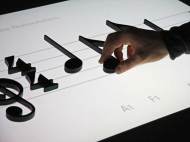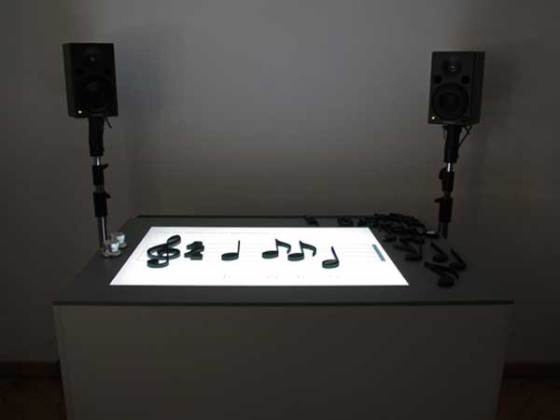Noteput – an interactive music table with tangible notes
 Although it isnt’t hard to teach a child to play some tune on the piano or strum the guitar, teaching classical music notation is a bit more difficult in most cases. The Noteput table concept from designers Jonas Heuer and Jürgen Graef attempts to make learning music theory fun, and also more effective, by making the learning more fun through interaction and use of senses as hearing, sight and touch.
Although it isnt’t hard to teach a child to play some tune on the piano or strum the guitar, teaching classical music notation is a bit more difficult in most cases. The Noteput table concept from designers Jonas Heuer and Jürgen Graef attempts to make learning music theory fun, and also more effective, by making the learning more fun through interaction and use of senses as hearing, sight and touch.
The Noteput consists of a tabletop screen that is activated and displays a set of staves when a physical treble clef is placed on the table. The table has two modes, the first is a standard mode, where you can place notes on the table in a playful and experimental way and explore the related music outcome. The second mode is excercise mode, where excercises and tutorials of different topic and difficulty have to be mastered.
As soon as a note is placed on the staves, the respective sound is heard. That serves as a kind of preview and an orientation while putting the notes. If several notes are on the table, you can hit the play button and listen to the notes in relation to each other and considering note values. In addition to piano other instruments like guitar, flute, vibraphon or e-piano can be chosen. It is also possible to play the notes in a loop. Notes can be moved as it is playing to get immediate feedback resulting from the changes.
Heuer and Graef built and programmed a functional prototype of the Noteput with slightly reduced functions as a proof of concept. The notes and clef elements were cut out of thin wood plates and weighted differently with lead balls. It was the difference in weight, in addition to their difference in form, that allowed the differentiation between whole, half, quarter and eighth notes. Long note values are heavier than short ones, for example.
They were then painted matte black and a unique marker was placed on the back of each object that allows them to be tracked with a camera placed inside the table. The software made using the vvvv visual programming language recognizes the marker and is able to define the length of the note and its position on the staves. A vvvv-patch computes the respective note sequence from this data and sends it via MIDI to sound software, which then plays the signals for different instruments.
Although Noteput isn’t finished, it shows a great potential by bringing interactivity into learning classical music notation.










Leave your response!